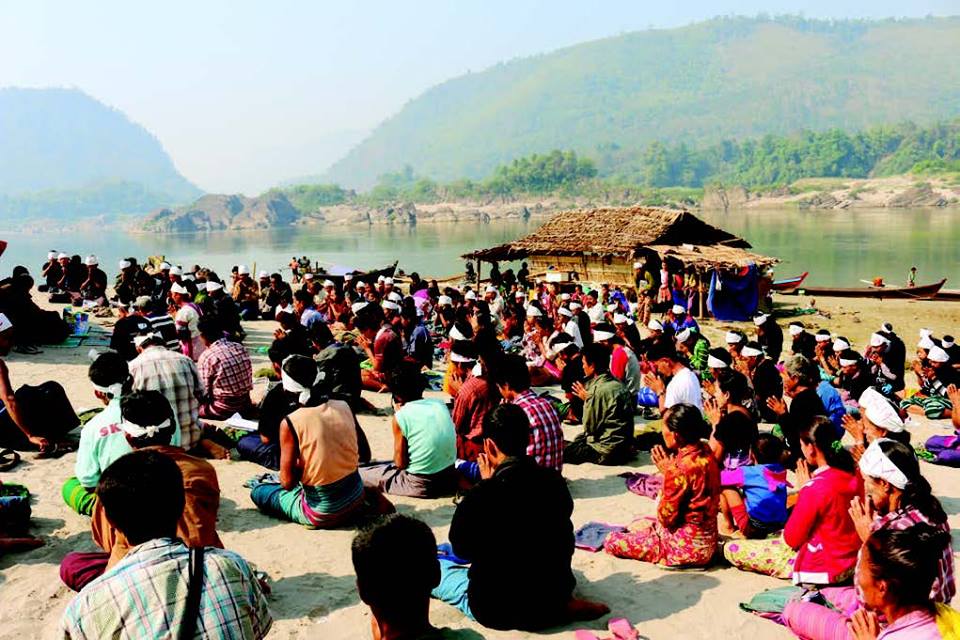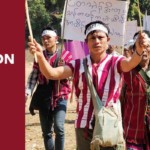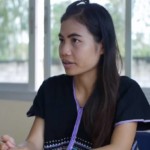Press Release by the Karen Rivers Watch (KRW), November 7, 2014
More than 2,000 villagers were displaced in October as fighting resumed in Karen State, the site of the world’s longest-running civil war. A report released today by Karen Rivers Watch (KRW) reveals that the outbreak of fighting – after two years of ceasefire negotiations and relative calm – appears to be part of a calculated military strategy by Burmese forces to control territory in Karen State, possibly motivated by plans to construct the Hatgyi Dam on the Salween River.
As world leaders, including Barack Obama, prepare to visit Burma for the East Asian Summit, the peace process in Burma is in real danger of falling apart. KRW urges world leaders to pressure Burma’s government to halt military offensives and pursue genuine peace.
In the report Afraid to Go Home, KRW details the escalation of violent conflict in two districts in Burma’s Karen State in October 2014 – a story that has been underreported in the media. KRW field interviews reveal a story of forced displacement and serious violations of human rights at the hands of Burmese government forces.
The report is available here:
http://kesan.asia/index.php/resources/publications-media/reports/viewdownload/4-reports/156-afraid-togo-
home-recent-violent-conflict-and-human-rights-abuses-in-karen-state
Key findings:
• The Burmese Army and associated Border Guard Force (BGF) have violated the 2012 ceasefire by attacking the Democratic Karen Benevolent Army (DKBA) in September and October 2014.
• Evidence suggests a coordinated Burmese military campaign to extend control along the Salween River, likely motivated by plans to start construction on the controversial Hatgyi Dam.
• The Burmese Army and BGF have committed human rights violations against civilian villagers, including looting homes, confiscating property, and taking at least 100 people for forced labor.
• Civilian villages were hit with mortar fire, forcing over 2,000 people to flee their homes. Most remain in hiding, afraid to return because Burmese troops continue to occupy their villages.
• Those who fled are in need of humanitarian assistance, but Burmese military restrictions on access to the area have hampered delivery of aid.
One woman who fled the fighting told KRW: “We are just farmers. We raised our pigs and chickens. They were almost ready to eat, but then we had to run, and the soldiers took everything.”
Recent conflict raises serious questions about foreign investment and development in Karen State. “Villagers and Karen resistance leaders in the area believe they are being attacked to make way for the Hatgyi Dam,” said KRW spokesperson Saw Tha Phoe. “We are currently conducting further research on how Hatgyi Dam and other development projects are linked to recent conflict in Karen State.”
Contact:
Saw Tha Phoe (Burmese and Karen): +95 (0) 9254886582
Saw Alex (Burmese and English): +66 (0) 813869925 / +95 (0) 9254207842
Email: karenriverswatch@gmail.com
NOTES TO EDITOR:
Conflict Area
The new military operations by the Burmese Army which have led to conflict and displacement are taking place in Hpa-An District’s Hlaingbwe (Karen name: Lu Pleh) Township and Hpapun (Karen name: Mutraw) District’s Bu Tho and Dwe Lo Townships.
Armed Groups
Border Guard Force (BGF) units in Karen State largely consist of former Democratic Karen Buddhist Army units. The Democratic Karen Buddhist Army split from the Karen National Liberation Army
(KNLA) in 1994, and has been fighting alongside the Burmese Army ever since. Parts of the Democratic Karen Buddhist Army officially became BGF under direct control of the Burmese Army in 2010. The
remaining Democratic Karen Buddhist Army troops refused to become a Border Guard Force and broke away from the Burmese Army. This group subsequently rebranded itself the Democratic Karen Benevolent Army, thus becoming the present-day DKBA who were involved in the recent clashes with the Burmese Army and BGF.
Hatgyi Dam
Conflict in Karen State has delayed construction of the Hatgyi Dam for over a decade. However, an MoU was signed in 2010, in order to revive the project. Foreign investment will come from China’s Sinohydro Corporation and the Electricity Generating Authority of Thailand (EGAT), and the dam is projected to have a capacity of 1,360 MW. The Hatgyi project has come under heavy criticism for inadequate scientific study, lack of transparency, potential ecological harm, negative impacts on downstream fishing and farming populations, and failure to consult local communities.
You can also download the report from Burma Link’s website (PDF).


![‘The Burma Army Killed Him [Saw O Moo] – At Least the Government or the Army Should Commit to Not Do This Again’: Paul Sein Twa, Executive Director of KESAN](https://www.burmalink.org/wp-content/uploads/2018/05/Saw-O-Moo-commemoration-Paul-Sein-Twa-speaking-2-150x150.jpg)




![‘They [IDPs] Cannot Buy Medicine Anymore’: Saw Hser Htoo Plaw, Leader of Karen IDP Camp (UPDATE)](https://www.burmalink.org/wp-content/uploads/2018/01/Hser-Htoo-Plaw-profile-150x150.jpg)